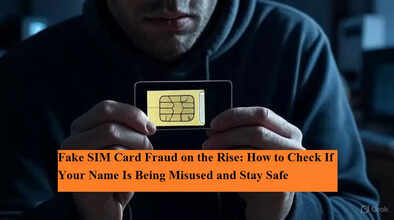Fake SIM Card Fraud on the Rise: How to Check If Your Name Is Being Misused and Stay Safe

Cyber fraud cases involving fake SIM cards are increasing rapidly in India. Fraudsters are using forged identity documents to issue SIM cards in other people’s names, which are then misused for financial crimes. With the help of OTP theft and phishing calls, scammers are draining money from unsuspecting victims’ bank accounts. Here’s how the scam works, what to do if you are targeted, and simple preventive tips to stay protected.
How Does Fake SIM Card Fraud Work?
Fraudsters often obtain a duplicate SIM card by using forged copies of Aadhaar or other identity proofs. Once activated, this fake SIM gets linked to the victim’s mobile number. Since most banking, UPI, and email services rely on OTP (One-Time Password) verification, criminals use this fake SIM to intercept OTPs. With access to these OTPs and login credentials, they can transfer money directly from the victim’s bank account.
Sometimes, cybercriminals also make phishing calls pretending to be bank officials, telecom representatives, or even government officers. During such calls, they trick victims into revealing confidential details like account numbers, card CVV, or internet banking passwords. These details are then used to execute large-scale financial fraud.
Signs That You Might Be a Victim
-
Sudden network loss: If your mobile phone suddenly loses network coverage without reason, it could be a sign of SIM swapping.
-
Unusual bank activity: Unexpected SMS alerts or account transactions you didn’t initiate may indicate misuse.
-
Unfamiliar calls or texts: Receiving OTPs or messages for services you didn’t request is another warning sign.
What to Do If You Fall Victim?
-
Contact your bank immediately – If money has been withdrawn fraudulently, report it without delay to your bank’s helpline or nearest branch. Ask them to freeze your account temporarily to prevent further loss.
-
Report to your telecom provider – If you notice suspicious activity on your mobile number, reach out to your service provider to block the fake SIM immediately.
-
File a cybercrime complaint – The Government of India has a dedicated portal: www.cybercrime.gov.in where you can lodge complaints online.
-
Call the National Helpline 1930 – Victims of cyber fraud can dial this toll-free number for immediate assistance and to register their case.
Preventive Measures to Stay Safe
-
Never share OTPs or banking details – Legitimate institutions will never ask for these.
-
Secure your identity documents – Do not share Aadhaar or other IDs casually. Always mark photocopies with “For Verification Purpose Only” to prevent misuse.
-
Stay alert for phishing attempts – Avoid clicking on suspicious links or downloading unverified apps.
-
Act quickly on network issues – If your phone suddenly loses signal for long durations, immediately check with your telecom provider to ensure your SIM has not been duplicated.
Why Awareness Matters
Fraudsters are constantly upgrading their methods, making it vital for individuals to remain cautious. Fake SIM card scams are not just about financial loss; they can also put your personal identity at risk. Criminals may use such SIMs for illegal activities, leaving you vulnerable to false accusations.
By staying alert, reporting incidents immediately, and following preventive measures, you can safeguard your finances as well as your digital identity.
Key Takeaway
Fake SIM card fraud is becoming one of the biggest cyber threats today. Anyone can become a target, but timely vigilance and prompt action can stop fraudsters in their tracks. Always monitor your mobile number activity, safeguard your identity documents, and remember – when in doubt, never share personal details over calls or messages.
If you suspect fraud, dial 1930 or report it at cybercrime.gov.in right away. Quick action could save you from major financial loss.

